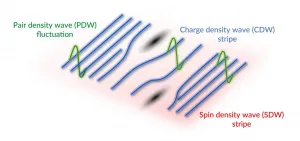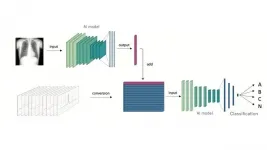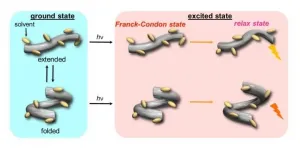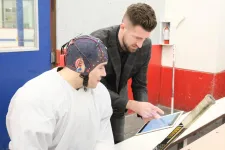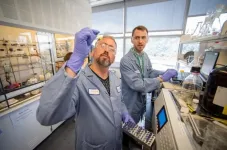(Press-News.org) Unconventional superconductors contain a number of exotic phases of matter that are thought to play a role, for better or worse, in their ability to conduct electricity with 100% efficiency at much higher temperatures than scientists had thought possible - although still far short of the temperatures that would allow their wide deployment in perfectly efficient power lines, maglev trains and so on.
Now scientists at the Department of Energy's SLAC National Accelerator Laboratory have glimpsed the signature of one of those phases, known as pair-density waves or PDW, and confirmed that it's intertwined with another phase known as charge density wave (CDW) stripes - wavelike patterns of higher and lower electron density in the material.
Observing and understanding PDW and its correlations with other phases may be essential for understanding how superconductivity emerges in these materials, allowing electrons to pair up and travel with no resistance, said Jun-Sik Lee, a SLAC staff scientist who led the research at the lab's Stanford Synchrotron Radiation Lightsource (SSRL).
Even indirect evidence of the PDW phase intertwined with charge stripes, he said, is an important step on the long road toward understanding the mechanism behind unconventional superconductivity, which has eluded scientists over more than 30 years of research.
Lee added that the method his team used to make this observation, which involved dramatically increasing the sensitivity of a standard X-ray technique known as resonant soft X-ray scattering (RSXS) so it could see the extremely faint signals given off by these phenomena, has potential for directly sighting both the PDW signature and its correlations with other phases in future experiments. That's what they plan to work on next.
The scientists described their findings today in Physical Review Letters.
Untangling superconductor secrets
The existence of the PDW phase in high-temperature superconductors was proposed more than a decade ago and it's become an exciting area of research, with theorists developing models to explain how it works and experimentalists searching for it in a variety of materials.
In this study, the researchers went looking for it in a copper oxide, or cuprate, material known as LSCFO for the elements it contains - lanthanum, strontium, copper, iron and oxygen. It's thought to host two other phases that may intertwine with PDW: charge density wave stripes and spin density wave stripes.
The nature and behavior of charge and spin stripes have been explored in a number of studies, but there had been only a few indirect glimpses of PDW - much like identifying an animal from its tracks - and none made with X-ray scattering techniques. Because X-ray scattering reveals the behavior of an entire sample at once, it's thought to be the most promising way to clarify whether PDW exists and how it relates to other key phases in cuprates, Lee said.
Over the past few years, the SSRL team has worked on increasing the sensitivity of RSXS so it could capture the signals they were looking for.
Postdoctoral researcher Hai Huang and SLAC staff engineer Sang-Jun Lee used the improved technique in this study. They scattered X-rays off LSCFO and into a detector, forming patterns that revealed what was going on inside the material. As they dropped the temperature of the material toward its superconducting range, spin stripes appeared and intertwined to form charge stripes, and those charge stripes were then associated with the emergence of two-dimensional fluctuations that are the hallmark of PDW.
The researchers said these results not only demonstrate the value of the new RSXS approach, but also support the possibility that the PDW is present not just in this material, but in all of the superconducting cuprates.
A research team led by Masaki Fujita at Tohoku University in Japan grew the high-quality LSCFO crystal used in the experiment and conducted preliminary tests on it there. The research was funded by the DOE Office of Science. SSRL is a DOE Office of Science user facility.
INFORMATION:
Citation: Hai Huang et al., Physical Review Letters, 21 April 2021 (10.1103/PhysRevLett.126.167001)
SLAC is a vibrant multiprogram laboratory that explores how the universe works at the biggest, smallest and fastest scales and invents powerful tools used by scientists around the globe. With research spanning particle physics, astrophysics and cosmology, materials, chemistry, bio- and energy sciences and scientific computing, we help solve real-world problems and advance the interests of the nation.
SLAC is operated by Stanford University for the U.S. Department of Energy's Office of Science. The Office of Science is the single largest supporter of basic research in the physical sciences in the United States and is working to address some of the most pressing challenges of our time.
Substantial proportions of pregnant and postpartum women scored high for symptoms of anxiety, depression, loneliness and post-traumatic stress in relation to COVID-19 in a survey carried out in May and June 2020, according to a new study published this week in the open-access journal PLOS ONE by Karestan Koenen and Archana Basu of Harvard T.H. Chan School of Public Health, US, and colleagues.
Pregnant and postpartum women face unique challenges during the COVID-19 pandemic that may put them at elevated risk of mental health problems. These include concerns about ...
Time seems to pass more slowly in the UK COVID-19 lockdown - especially for people who are depressed, shielding or dissatisfied with social interactions
INFORMATION:
Article Title: Distortions to the passage of time during England's second national lockdown: A role for depression
Funding: The author received no specific funding for this work.
Competing Interests: The authors have declared that no competing interests exist.
Article URL: https://journals.plos.org/plosone/article?id=10.1371/journal.pone.0250412
...
Survey of 3,536 healthcare workers suggests 67 percent are suffering burnout, but people who receive frequent COVID-19 tests are less likely to be burned out.
INFORMATION:
Article Title: Determinants of burnout and other aspects of psychological well-being in healthcare workers during the Covid-19 pandemic: A multinational cross-sectional study
Funding: JK has received an educational grant from Johnson and Johnson.
Competing Interests: JK has received an educational grant from Johnson and Johnson. This does not alter our adherence to PLOS ONE ...
Kobe University Hospital's Dr. NISHIMORI Makoto and Project Assistant Professor KIUCHI Kunihiko et al. (of the Division of Cardiovascular Medicine, Department of Internal Medicine) have developed an AI that uses multiple kinds of test data to predict the location of surplus pathways in the heart called 'accessory pathways', which cause the heart to beat irregularly. In this study, the researchers were able to improve diagnosis accuracy by having the AI learn from two completely different types of test results- electrocardiography (ECG) data and X-ray images. It is hoped that this methodology can be applied to other disorders based upon the successful results of this research.
These ...
Stimulus-responsive supramolecular structures have emerged as an alternative to conventional ones, owing to their applications in sensing, drug delivery, and switchable memory systems. Now, scientists at Tokyo Institute of Technology explore the hydrostatic-pressure response of "foldamers"--artificial molecules that mimic protein folding--and report a shift in their preferred conformation with changing pressure, demonstrating hydrostatic pressure-enabled dynamic control. The finding opens doors to future development of pressure-sensitive foldamers and artificial materials.
Most, if not all, biological systems are extremely complex and often rely on interactions traditional ...
Animals use their sense of smell to navigate the world--to find food, sniff out mates and smell danger. But when a hungry animal smells food and a member of the opposite sex at the same time, what makes dinner the more attractive option? Exactly what is it about the odor of food that says, "Choose me?"
Research by investigators at Harvard Medical School illuminates the neurobiology that underlies food attraction and how hungry mice choose to pay attention to one object in their environment over another.
In their study, published March 3 in Nature, Stephen Liberles and co-author Nao Horio, identified the pathway that promotes attraction ...
STUDY SHOWS VACCINES MAY PROTECT AGAINST NEW COVID-19 STRAINS ... AND MAYBE THE COMMON COLD
A new study by Johns Hopkins Medicine researchers provides evidence that CD4+ T lymphocytes -- immune system cells also known as helper T cells -- produced by people who have received either of the two messenger RNA (mRNA) vaccines for COVID-19 caused by the original SARS-CoV-2 strain also will recognize the mutant variants of the coronavirus that are rapidly becoming the dominant types worldwide.
The researchers say this suggests that T cell responses elicited or enhanced by the vaccines should be able to control the current ...
Surrey, B.C. Canada and Rochester, Minn., U.S. (April 22, 2021) - Neuroscience researchers at Mayo Clinic Orthopedics and Sports Medicine in Rochester, Minnesota, U.S., the Health and Technology District and Simon Fraser University (SFU) in Surrey, British Columbia, Canada have published the latest results of their ongoing multi-year hockey concussion study examining changes in subconcussive cognitive brain function in male youth ice hockey players.
The research team monitored brain vital signs during pre- and post-season play in 23 Bantam (age 14 or under) and Junior A (age 16 to 20) male ice-hockey players in Rochester, Minnesota.
"Brain vital signs" translates complex ...
Plastics are a part of nearly every product we use on a daily basis. The average person in the U.S. generates about 100 kg of plastic waste per year, most of which goes straight to a landfill. A team led by Corinne Scown, Brett Helms, Jay Keasling, and Kristin Persson at Lawrence Berkeley National Laboratory (Berkeley Lab) set out to change that.
Less than two years ago, Helms announced the invention of a new plastic that could tackle the waste crisis head on. Called poly(diketoenamine), or PDK, the material has all the convenient properties of traditional plastics while avoiding the environmental pitfalls, because unlike traditional plastics, PDKs can be recycled indefinitely ...
Living away from community and country, Aboriginal families of children with severe burns also face critical financial stress to cover the associated costs of health care and treatment, a new study shows.
An Australian study, led by Flinders researchers Dr Courtney Ryder and Associate Professor Tamara Mackean, found feelings of crisis were common in Aboriginal families with children suffering severe burns, with one family reporting skipping meals and others selling assets to reduce costs while in hospital.
The economic hardship was found to be worse in families who live in rural areas - some households travelling more ...
